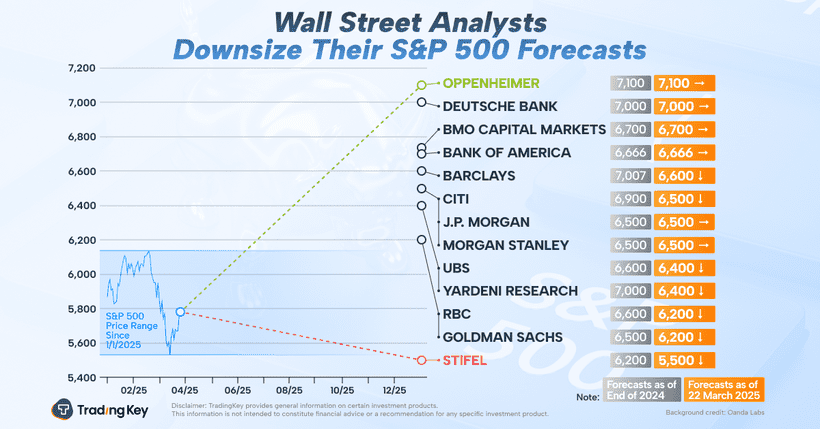Japanese Yen stands firm near multi-month peak against a broadly weaker USD

- The Japanese Yen continues to attract safe-haven flows amid the escalating US-China trade war.
- The divergent BoJ-Fed policy expectations provide an additional boost to the lower-yielding JPY.
- Hopes that Japan might strike a trade deal with the US contribute to the bid tone around the JPY.
The Japanese Yen (JPY) attracts fresh buyers at the start of a new week and remains within striking distance of its highest level since late September 2024 touched against a broadly weaker US Dollar (USD) last Friday. Concerns about the rapidly escalating US-China trade war and its impact on the global economy continue to underpin traditional safe-haven assets, including the JPY. Furthermore, hopes that Japan might strike a trade deal with the US turned out to be another factor offering support to the JPY.
Meanwhile, signs of broadening inflation in Japan keep the door open for more interest rate hikes by the Bank of Japan (BoJ). In contrast, investors have been pricing in the possibility of aggressive policy easing by the Federal Reserve (Fed) amid worries that the escalating US-China trade war would hinder the US economic growth. This would result in a further narrowing of the rate differential between Japan and the US, which suggests that the path of least resistance for the lower-yielding JPY is to the upside.
Japanese Yen draws support from a global flight to safety and BoJ rate hike bets
- China’s 84% tariffs on US goods took effect on Thursday, while US President Donald Trump hiked duties on Chinese imports to an unprecedented 145%. The developments fuel worries about the potential economic fallout from the escalating trade war between the world's two largest economies and drive some safe-haven flows toward the Japanese Yen.
- Investors remain optimistic about a positive outcome from US-Japan trade talks. In fact, Trump said last week that tough but fair parameters are being set for a negotiation. Adding to this, US Treasury Secretary Scott Bessent said that Japan may be a priority in tariff negotiations, fueling hopes for a possible US-Japan trade deal and further underpinning the JPY.
- Japanese Prime Minister (PM) Shigeru Ishiba warned on Monday that “US tariffs have the potential to disrupt the world economic order.” Separately, Japan’s Finance Minister Shunichi Kato said that “the US and Japan share the view that excessive FX volatility is undesirable.” Moreover, Japan's Economy Minister Ryosei Akazawa stated that "the FX issues will be dealt with between Finance Minister Kato and US Treasury Secretary Scott Bessent."
- Meanwhile, the Bank of Japan's preliminary report released last Thursday showed that annual wholesale inflation accelerated to 4.2% in March. This is a sign of persistent cost pressures, which, along with strong wage growth, should contribute to mounting domestic inflationary pressure and allow the BoJ to continue raising interest rates this year.
- In contrast, the latest reading of the US Consumer Price Index indicated that inflation slowed sharply in March. This comes on top of the weakening confidence in the US economy and should allow the Federal Reserve to resume its rate-cutting cycle. Moreover, market participants are now pricing in the possibility of 90 basis points of rate cuts by the end of this year.
- The divergent BoJ-Fed policy expectations turn out to be another factor that benefits the lower-yielding JPY. The US Dollar, on the other hand, languishes near its lowest level since April 2022 touched on Friday. This, in turn, drags the USD/JPY pair back closer to a multi-month low during the Asian session on Monday and supports prospects for further losses.
USD/JPY needs to consolidate before the next leg down; 142.00 holds the key

From a technical perspective, the daily Relative Strength Index (RSI) is on the verge of breaking into the oversold territory and warrants some caution for bearish traders. Hence, it will be prudent to wait for some near-term consolidation or a modest bounce before positioning for an extension of over a three-month-old downtrend. In the meantime, the 142.00 mark, or a multi-month low touched on Friday, could offer some support to the USD/JPY pair. A convincing break below could drag spot prices towards the 141.65-141.60 intermediate support en route to the 141.00 mark. Some follow-through selling below the 140.75 zone might expose the September 2024 swing low, around the 140.30-140.25 region, before the pair eventually drops to the 140.00 psychological mark.
On the flip side, any attempted recovery back above the 143.00 mark is likely to confront stiff resistance near the 143.50-143.55 zone. The subsequent move up could lift the USD/JPY pair to the Asian session peak, around the 144.00 round figure, which if cleared decisively might trigger a short-covering rally to the 144.45-144.50 horizontal resistance. The momentum could extend further towards reclaiming the 145.00 psychological mark en route to the 145.50 zone and the 146.00 round figure.
Japanese Yen FAQs
What key factors drive the Japanese Yen?
The Japanese Yen (JPY) is one of the world’s most traded currencies. Its value is broadly determined by the performance of the Japanese economy, but more specifically by the Bank of Japan’s policy, the differential between Japanese and US bond yields, or risk sentiment among traders, among other factors.
How do the decisions of the Bank of Japan impact the Japanese Yen?
One of the Bank of Japan’s mandates is currency control, so its moves are key for the Yen. The BoJ has directly intervened in currency markets sometimes, generally to lower the value of the Yen, although it refrains from doing it often due to political concerns of its main trading partners. The BoJ ultra-loose monetary policy between 2013 and 2024 caused the Yen to depreciate against its main currency peers due to an increasing policy divergence between the Bank of Japan and other main central banks. More recently, the gradually unwinding of this ultra-loose policy has given some support to the Yen.
How does the differential between Japanese and US bond yields impact the Japanese Yen?
Over the last decade, the BoJ’s stance of sticking to ultra-loose monetary policy has led to a widening policy divergence with other central banks, particularly with the US Federal Reserve. This supported a widening of the differential between the 10-year US and Japanese bonds, which favored the US Dollar against the Japanese Yen. The BoJ decision in 2024 to gradually abandon the ultra-loose policy, coupled with interest-rate cuts in other major central banks, is narrowing this differential.
How does broader risk sentiment impact the Japanese Yen?
The Japanese Yen is often seen as a safe-haven investment. This means that in times of market stress, investors are more likely to put their money in the Japanese currency due to its supposed reliability and stability. Turbulent times are likely to strengthen the Yen’s value against other currencies seen as more risky to invest in.





